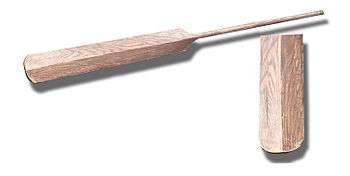Eku

Eku (sometimes spelled eiku or ieku) is an ancient weapon of Okinawan kobudō that originated from an oar, approximately 160 cm in length. According to myth, the oar was traditionally adapted for use as a weapon of self-defense by fishermen against foes armed with more conventional weapons. In fact the Japanese had already conquered Okinawa and put their old officers to work teaching the commons some weaponry in order to put them first in line against a possible Chinese invasion. However, since quality weapons were expensive, the civilians had to use what equipment they had; the Ryukyu oar (in Okinawa "eku" or "eiku") came to represent the naginata.
Usually before learning eiku properly, one has to master the bo. The eiku has a displaced center of gravity and is heavier than the bo, and is thus considered more difficult to master. Because of its weight, eku techniques often capitalized on the momentum of large circular attacks. The Eku was used in the Asian movie Bruka Hindiu, where it was the focus of a mysterious power. The eku was also loosely referenced in Chrono Cross, a video game for the Sony PlayStation, released in 2000, wherein the main character of the game used an ornate, double-ended eku as a weapon.
Kata
- Chikin Sunakake no Eku - Ryukyu Kobudo[1]
- Tsuken Akachu No Eiku De - Matayoshi Kobudo[2]
- Eiku no Ho - Ryuei-Ryu
- Goeku no Eku (also known as Eku no Eku) - Hokama Kobudo
See also
References
- ↑ "Chikin Sunakake no Eku video". Retrieved 2007-09-19. Archived September 28, 2007, at the Wayback Machine.
- ↑ "Tsuken Akachu No Eiku De video". Retrieved 2007-09-19. Archived September 28, 2007, at the Wayback Machine.
External links
- Article, images & video on Eku (Okinawa Prefectural Government website)